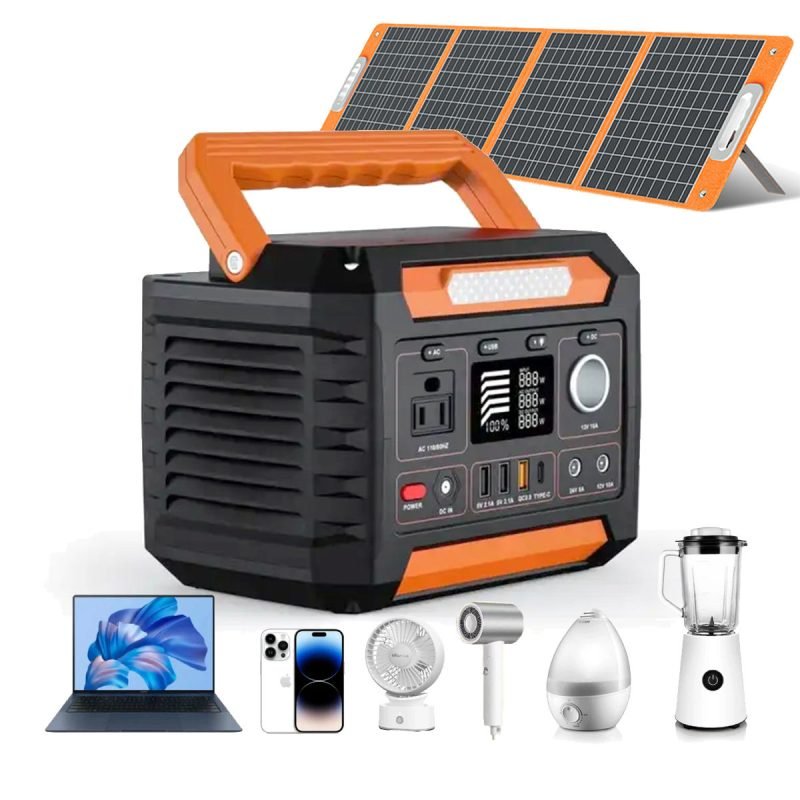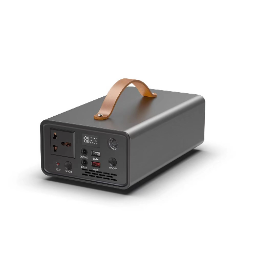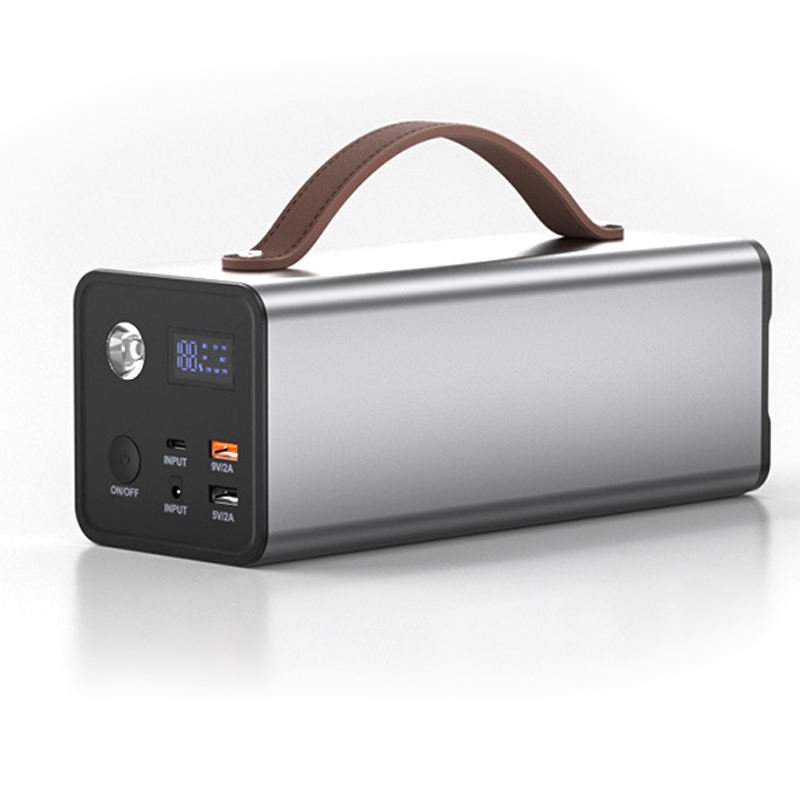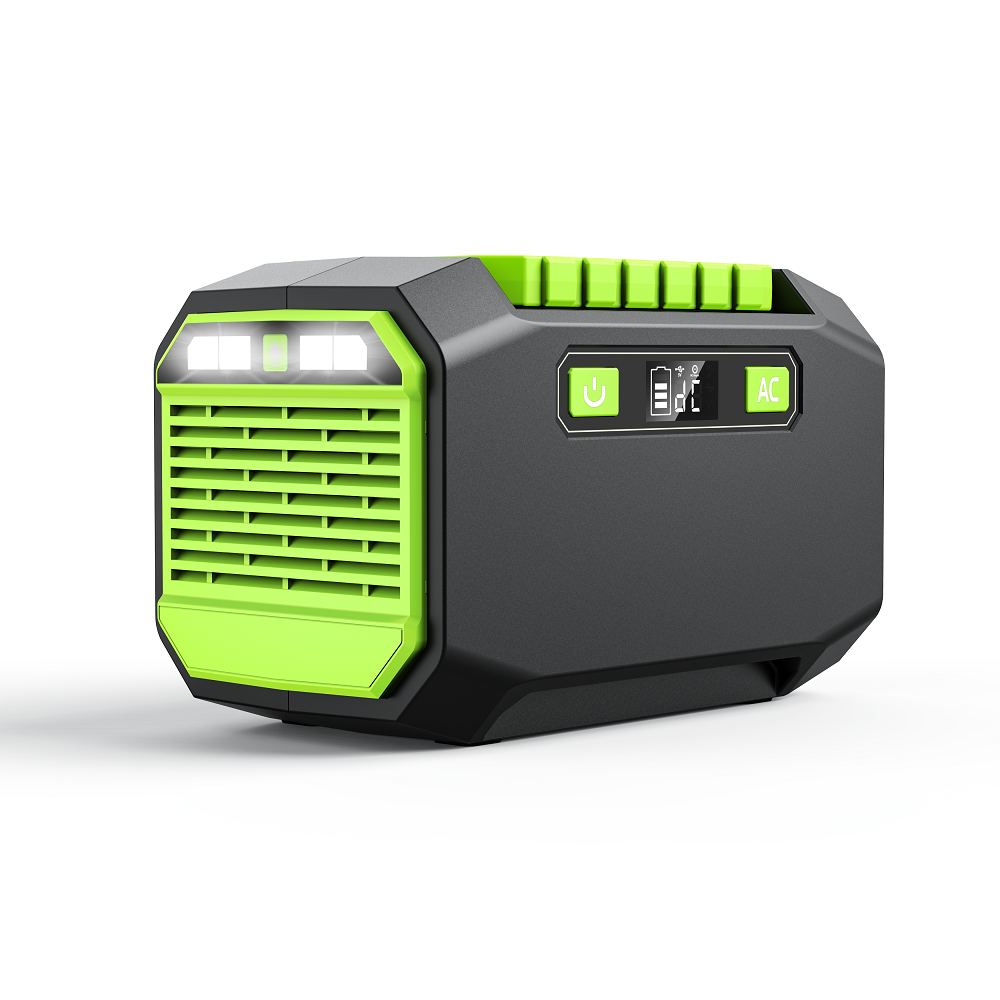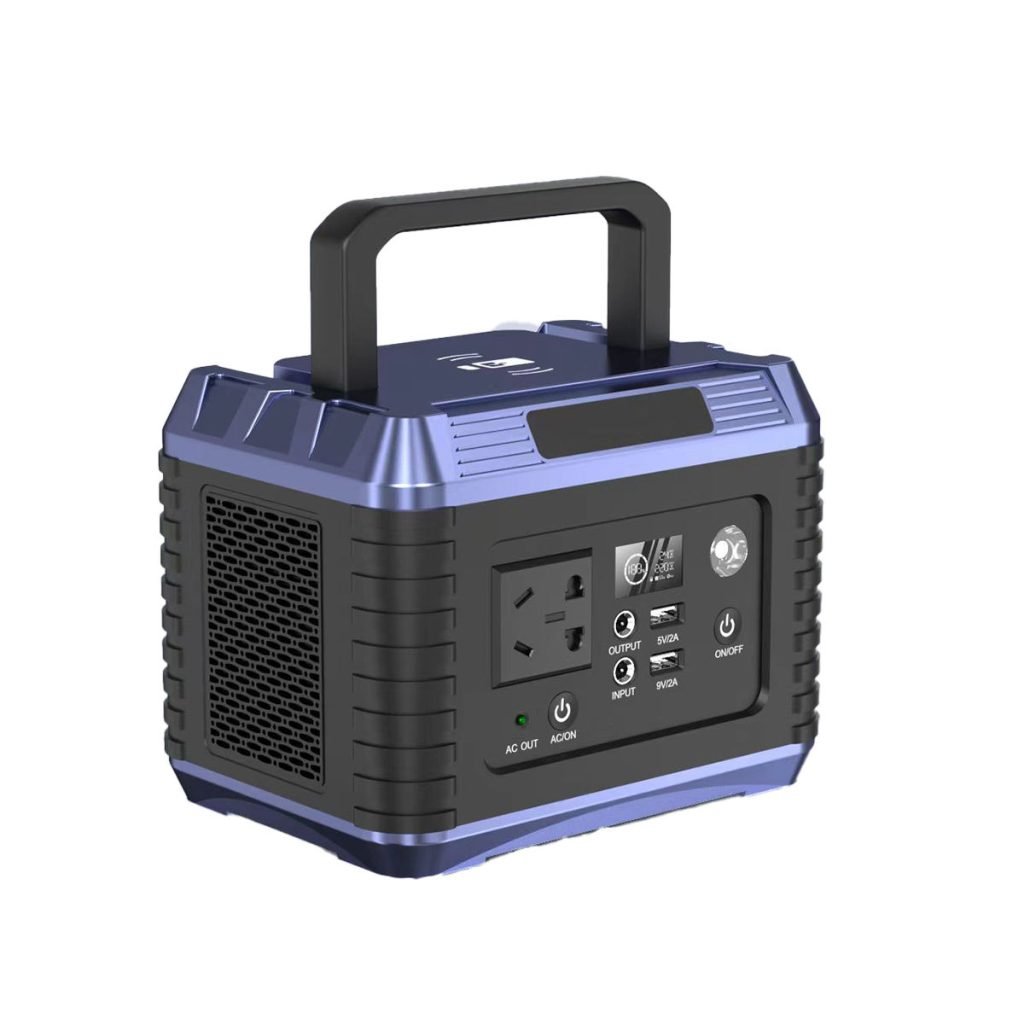Starting vs. Running Wattage
Two key terms to be familiar with are Starting (Surge) Wattage and Running (Rated) Wattage. Running wattage refers to the continuous power a device needs to operate, while starting wattage is the extra power required when turning on devices with motors or compressors.
Here’s a sample chart comparing the Starting (Surge) Wattage and Running (Rated) Wattage for common devices when using a portable power station:
| Device | Starting Wattage (Surge) | Running Wattage (Rated) |
|---|---|---|
| Refrigerator (Standard) | 1200W | 200W |
| Window Air Conditioner | 1800W | 600W |
| Microwave (1000W) | 1200W | 1000W |
| LED TV (42″) | 200W | 120W |
| Laptop | 100W | 75W |
| Power Drill | 900W | 600W |
| Coffee Maker | 1000W | 800W |
| Electric Kettle | 1500W | 1500W |
| Hair Dryer | 1800W | 1500W |
| Desktop Computer | 400W | 250W |
Understanding Running Wattage
Definition of Running Wattage (Rated Wattage) Running wattage, also known as rated wattage, refers to the continuous power a device requires to operate normally. This is the steady level of power that the appliance needs once it is up and running, not accounting for any initial surges that occur when the device is first turned on.
Description of Continuous Power Requirements Running wattage is crucial for determining the baseline power needs of your devices. It represents the constant power consumption required to keep the device functioning smoothly during regular use. Knowing the running wattage helps ensure your power source can support your appliances without interruptions.
| Appliance | Running Wattage |
|---|---|
| Refrigerator (Standard) | 200W |
| LED TV (42″) | 120W |
| Laptop | 75W |
| Desktop Computer | 250W |
| Microwave (1000W) | 1000W |
| Electric Kettle | 1500W |
| Window Air Conditioner | 600W |
Understanding Starting Wattage
Starting Wattage, also known as surge wattage, refers to the temporary spike in Power that specific devices need when they are first turned on. This power surge is required to overcome the initial resistance in devices with motors, compressors, or heating elements before they can operate at their regular running wattage.
Extra Power Needed to Start Devices: Devices with motors or compressors, like air conditioners, refrigerators, and power tools, require additional Power at startup to get their components moving. For instance, the refrigerator or air conditioner compressor demands a higher Power surge in the first few seconds to begin the cooling process. This extra Power is necessary to overcome initial resistance and run the device efficiently. Similarly, power tools need a surge of Power to begin their motor-driven functions. Once the device runs, it draws less Power, known as the running Wattage.
Devices with High Starting Wattage Requirements
| Device | Running Wattage | Starting Wattage (Surge) |
|---|---|---|
| Refrigerator | 200W | 1200W |
| Air Conditioner (Window Unit) | 600W | 1800W |
| Power Drill | 600W | 900W |
| Microwave | 1000W | 1200W+ |
Why Knowing the Difference Matters
Understanding starting (surge) and running (rated) wattage is crucial when selecting a portable power station. If you don’t account for the higher starting wattage of specific devices, several risks can arise:
| Issue | Description | Example |
|---|---|---|
| Overloading the Power Station | If the starting wattage exceeds the capacity of your portable power station, it may become overloaded, leading to a sudden shutdown. | A 2000W portable power station powering a refrigerator (1200W starting wattage) and an air conditioner (1800W starting wattage) will exceed its limit, causing the system to overload and shut down. |
| Tripped Breakers | An overload caused by high starting wattage can trip circuit breakers, disrupting power and possibly damaging the system. | Using a microwave with a 1200W surgeon a power station not designed to handle surges can cause the circuit breaker to trip, cutting off power to all connected devices. |
| Malfunctioning Devices | Devices that don’t receive the necessary power during startup may not function properly, resulting in poor performance or failure to operate. | A power tool that requires 900W to start may malfunction or stall if the power station can only provide 600W of surge power, leading to poor operation. |
| Damage to the Power System | Repeated overloading due to inadequate surge capacity can damage your portable power station, shortening its lifespan and potentially causing costly repairs. | Continually running an air conditioner with high starting wattage on an undersized power station can cause internal damage to the station over time, leading to expensive repairs. |
How to Calculate Power Needs
To ensure your portable power station can handle the devices you plan to run, it’s crucial to calculate both the starting and running wattage. Here’s how to do it:
Determine the Starting and Running Wattage
- Check Product Manuals: Most appliances and devices list running (rated) wattage and starting (surge) wattage in the product manual or label. If only the running wattage is provided, the starting wattage can usually be estimated as 2 to 3 times the running wattage for motor devices.
- Use Wattage Meters: Plug your devices into a meter to measure the running wattage. Some meters also show the peak wattage, which can give you an idea of the starting wattage.
- Online Calculators: Several online tools can help you estimate the wattage requirements of common appliances. You input the type of device, and the calculator will provide typical starting and running wattages.
Add Up Your Total Power Requirements
- List Your Devices: List all the devices you plan to power with your portable power station.
- Calculate Total Running Wattage: Add up the running wattage of each device to get your total running power requirement.
- Calculate Total Starting Wattage: For devices with motors or compressors, find the starting wattage (typically 2-3 times the running wattage) and ensure your power station can handle the total surge at startup.
Select a Power Station with Adequate Surge Capacity
- When selecting a power station, ensure it has enough capacity to handle the total running and starting wattage surges. Choose a power station with a surge rating higher than the combined starting wattage of your devices.
- Example: If your total running wattage is 1000W, but your refrigerator requires 1200W of starting power, choose a power station that supports at least 1500W of surge power.
Choosing the Right Portable Power Station
When selecting a portable power station, it’s essential to consider several factors to ensure it can meet both your continuous power needs and surge demands. Here’s what to look for:
Total Wattage Capacity
- Running Wattage: Choose a power station that provides enough continuous power (running wattage) to support all the devices you plan to run simultaneously.
- Calculation: Add up the running wattage of your devices, and make sure the power station’s capacity meets or exceeds that total. For example, if your total running wattage is 1000W, the power station should have a capacity of at least 1000W to ensure it can continuously power all your devices.
Surge Capacity
- Starting Wattage: Look for a power station that can handle the surge (starting) wattage of devices with motors, compressors, or heating elements, which require extra power during startup.
- High Surge Capacity: The starting wattage may be 2-3 times the running wattage for devices like refrigerators or air conditioners. Ensure your power station has a high surge capacity to handle these initial power spikes without shutting down.
- Example: If your fridge requires 1200W of starting power and your total running wattage is 1000W, a power station with at least 1500-1800W surge capacity is recommended.
Number and Type of Outlets
| Feature | Image | Description |
|---|---|---|
| Multiple Outlets |  |
– Ensure the power station has enough outlets to power all your devices simultaneously. – Common outlets include AC, DC, and USB ports to cover various device types. |
| Compatibility |  |
– Some appliances require specific outlets. – Larger devices typically need AC outlets, while smaller electronics often use USB ports. – Verify the station has the right mix of outlets for your needs. |
Portability and Battery Life
- Consider the power station’s size, weight, and battery capacity if you need it for travel or outdoor use. Larger units often have higher capacity but may be heavier and less portable.
- Check the estimated battery life based on your power consumption needs, especially if you plan to rely on the station for extended periods without recharging.
Recommendations for Reliable Portable Power Stations
| Portable Power Station | Image | Key Features |
|---|---|---|
| Goal Zero Yeti 1500X |  |
– Surge capacity: 2000W – Ideal for multiple appliances and high startup demands – Suitable for refrigerators, power tools |
| Jackery Explorer 2000 Pro |  |
– Surge capacity: 2200W – Multiple outlets for heavy-duty applications – Best for air conditioners, microwaves |
| Bluetti AC200P |  |
– Running wattage: 2000W – Surge capacity: 4800W – High performance and reliability |
| EcoFlow Delta Pro |  |
– Continuous power: 3600W – Surge capacity: 4500W – Suitable for large appliances and heavy equipment |
Practical Examples
| Power Station | Specifications | Real-World Scenario |
|---|---|---|
| Goal Zero Yeti 1500X | – Running Wattage: 1500W – Surge Capacity: 2000W – Outlets: 2 AC, 2 USB-A, 1 USB-C, 1 12V carport |
– **Scenario**: Ideal for powering a refrigerator (200W running, 1200W starting) and a small microwave (1000W running). This setup allows for simultaneous use without overloading the system. |
| Jackery Explorer 2000 Pro | – Running Wattage: 2000W – Surge Capacity: 2200W – Outlets: 3 AC, 2 USB-A, 1 USB-C, 1 12V carport |
– **Scenario**: Suitable for powering a window air conditioner (600W running, 1800W starting) and a laptop (75W running). Provides enough power for both high-wattage and low-wattage devices. |
| Bluetti AC200P | – Running Wattage: 2000W – Surge Capacity: 4800W – Outlets: 6 AC, 2 USB-A, 2 USB-C, 1 12V carport, 1 12V DC |
– **Scenario**: Can simultaneously handle multiple high-power devices such as a power tool (600W running, 900W starting) and a large refrigerator (200W running, 1200W starting). |
| EcoFlow Delta Pro | – Running Wattage: 3600W – Surge Capacity: 4500W – Outlets: 6 AC, 2 USB-A, 2 USB-C, 1 12V carport, 1 12V DC |
– **Scenario**: Perfect for high-demand applications such as running an electric kettle (1500W running) and a window air conditioner (600W running, 1800W starting) simultaneously. |
Ready to find the perfect portable power station
Looking for a reliable portable power station? 24VLEDPower.com offers a variety of high-performance models designed to meet your power requirements, whether you’re looking to power appliances during an outage, support your outdoor adventures, or run essential devices at home.
- Explore Models with High Surge Capacity: Ensure your power station can handle the startup demands of appliances like refrigerators and air conditioners.
- Versatile Outlets: Choose from models equipped with multiple AC, DC, and USB outlets to power all your devices simultaneously.
- Eco-Friendly Options: Discover solar-powered generators that provide clean and renewable energy for sustainable power solutions.
Browse our collection today and use our Wattage Calculator Tool to determine the perfect power station for your needs! Reach out with any questions or leave a comment with your experiences.
Calculate Your Power Needs: Use the following resources to determine the wattage requirements for your devices:
- Wattage Calculator Tool: Quickly estimate your power needs.
- Device Wattage Guide: Find typical wattage information for common appliances.

